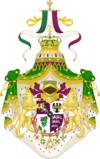Monarchy of Barcia: Difference between revisions
(Created page with "{{WIP}} {{region icon Levilion}} {{Infobox monarchy | royal_title = Monarchy | realm = Barcia | border = <!-- Optional. Accepted values: provincial / federal / imperial --> | coatofarms = Barcia Greater Coat of Arms.png | coatofarmssize = 100px | coatofarmscaption = Royal Coat of Arms | image = 150px | caption = '''Maria III''' | first_monarch = | last_monarch =...") |
|||
| (3 intermediate revisions by the same user not shown) | |||
| Line 30: | Line 30: | ||
==Succession== | ==Succession== | ||
==List of Monarchs== | ==List of Monarchs== | ||
===House of Sabino=== | |||
{| width=95% class="wikitable" | |||
! width=8% | Portrait | |||
! width=10%|Coat of arms | |||
! width=20% | Name | |||
! width=7% | Monarch from | |||
! width=7% | Monarch until | |||
! width=15% | Claim | |||
! width=10% | Title | |||
|- | |||
|align="center"|[[File:Luigi Amedeo, Duke of the Abruzzi.jpg|100px]] | |||
|align="center"|[[image:Barcia Greater Coat of Arms.png|100px]] | |||
|align="center"|Emanuele III | |||
|align="center"|12 January 1894 | |||
|align="center"|8 September 1915 | |||
|{{*}}Son of Philip III and Eleanor of Vervillia | |||
|rowspan=2 align="center"|King of Barcia<br>(Re di Barcia) | |||
|- | |||
|align="center"|[[File:Prince Vittorio Emanuele, Count of Turin in 1895 (crop).jpg|100px]] | |||
|align="center"|[[image:Barcia Greater Coat of Arms.png|100px]] | |||
|align="center"|Phillip VII<br><small>Filippo VII</small> | |||
|align="center"|8 September 1915 | |||
|align="center"|18 June 1916 | |||
|{{*}}Son of Emanuele III and Louise-Augustine | |||
|- | |||
|align="center"|[[File:The Yugoslav Government in Exile during the Second World War CM5648.jpg|100px]] | |||
|align="center"|[[image:Barcia Greater Coat of Arms.png|100px]] | |||
|align="center"|Umberto V | |||
|align="center"|18 June 1916<small> (disputed)</small><br>11 Feburary 1944 <small>(coronation)</small> | |||
|align="center"|14 April 1967 | |||
|{{*}}Nephew of Phillip VII, son of Prince Luigi and Catherine of Orlesso | |||
|align="center" rowspan=2|King of Barcia<br>(Re di Barcia) | |||
|- | |||
|align="center"|[[File:Victor Emmanuel of Savoie (0) (cropped).jpg|100px]] | |||
|align="center"|[[image:Barcia Greater Coat of Arms.png|100px]] | |||
|align="center"|Umberto VI | |||
|align="center"|14 April 1967 | |||
|align="center"|4 November 1996 | |||
|{{*}}Son of Umberto V and Maria-Elise of Tyrnica | |||
|- | |||
|align="center"|[[File:Karaliene Sofija (cropped).jpg|100px]] | |||
|align="center"|[[image:Barcia Greater Coat of Arms.png|100px]] | |||
|align="center"|Maria III | |||
|align="center"|4 November 1996 | |||
|align="center"|Present | |||
|{{*}}Daughter of Umberto VI and Alicia of Viridia | |||
|align="center"|Queen of Barcia<br>(Regina di Barcia) | |||
|- | |||
|} | |||
[[Category:Barcia]] | [[Category:Barcia]] | ||
Latest revision as of 09:35, 31 August 2024
This article is incomplete because it is pending further input from participants, or it is a work-in-progress by one author. Please comment on this article's talk page to share your input, comments and questions. Note: To contribute to this article, you may need to seek help from the author(s) of this page. |
| Monarchy of Barcia | |
|---|---|
 Royal Coat of Arms | |
 Maria III | |
| Details | |
| Style | His/Her Majesty |
| Heir apparent | Vittorio, Prince of Ludovicia |
| Residence | Castello Forlana Castelloferro Palazzo Edera Palazzo Benemia |
| Appointer | Hereditary |
The Monarchy of Barcia is the form of government in which a hereditary monarchy rules over Barcia as head of state. Historically, the Barcian monarchs ruled as absolutists weilding almost complete power over the state and its subjects. Today the power of the monarch is mostly ceremonial with its authority greatly limited by the country's constitution implemented in the aftermath of the Second Great War. The incumbent of the Barcian monarchy is styled King or Queen of Barcia (Idrean: Re/Regina di Barcia). The current monarch of Barcia is Queen Maria III who has ruled over the country since 1996.
The Barcian monarch is responsible for the opening and closing of parliament as well as the appointment of the Chancellor of Barcia who constitutionally is the individual best able to command the confidence of the Parliament of Barcia, usually the leader of the largest party. Additionally, the monarch of Barcia is also responsible for welcoming foreign dignataries as well as performing a number of domestic and overseas diplomatic responsibilities. Barcia utilises a system of male-preference Primogeniture to dictate succession to the throne. Under this system the eldest male child of the reigning monarch inherits the throne, whilst females will only inherit the throne should they have no male siblings.
The Barcian monarchy has its origins in the House of Ludovicus who served as mercenaries and bodyguards to the Sabarine Emperor during the late First Empire. For their services the Ludovites were granted control over the island of Scalia but were soon able to launch of war of conquest against the empire which resulted in their capture of much of the empire's north-eastern territory as confirmed through the Treaty of Cerrescum. This treaty also granted the Ludovites the title of Grand Dukes of Barcia which they retained until the Twelfth Century when the title was usurped by the Emperor. Over time the Ludovites and their descendants the House of Sabino were able to rebuild their power in the empire's northeast, reclaiming the title of Grand Duke following the War of the Eagles. During the Great Upheaval, the Dukes of Barcia styled themselves as Kings marking Barcias promotion to the title of Kingdom within the Sabarine Empire and later Occidental Confederation.




